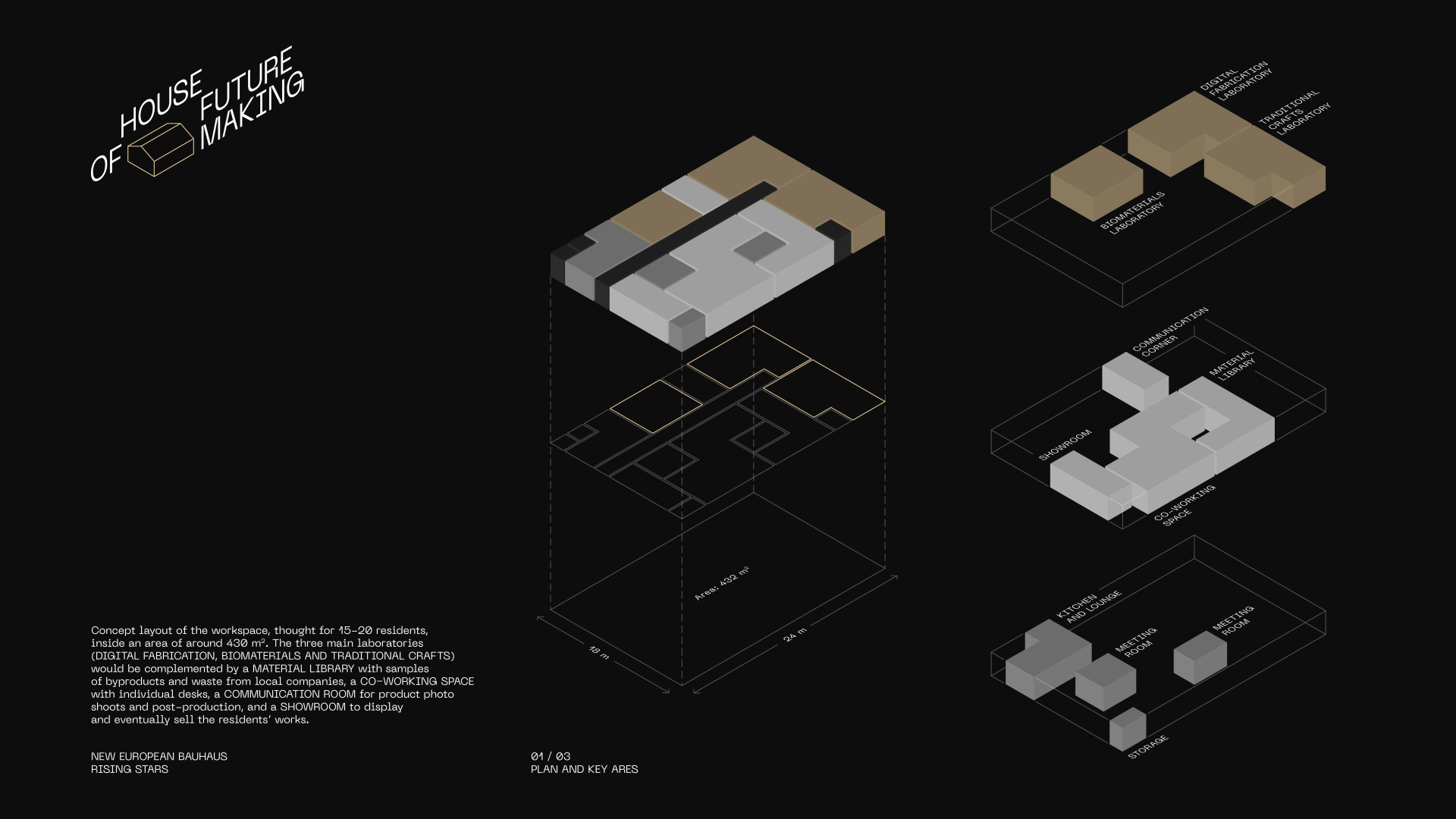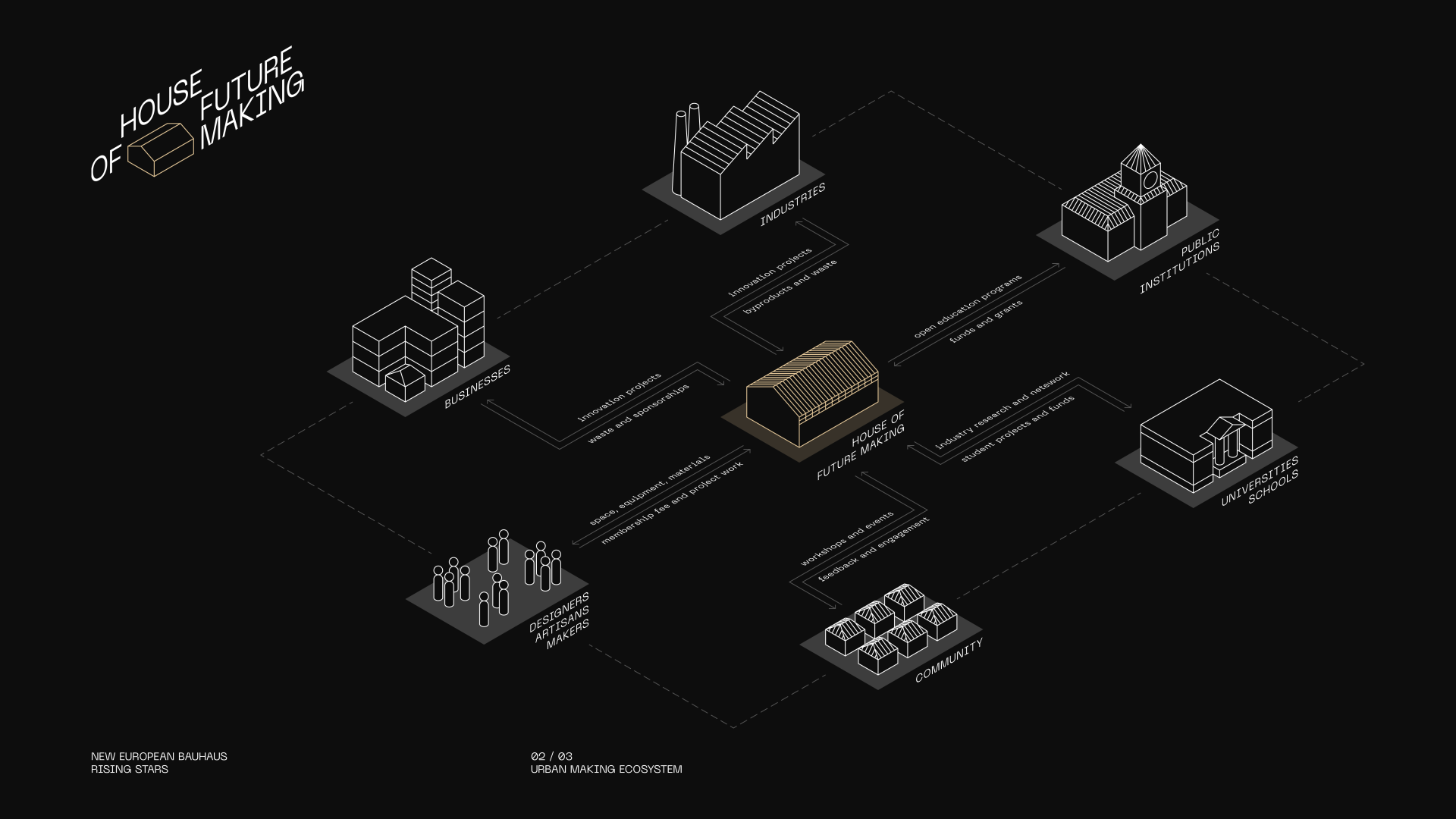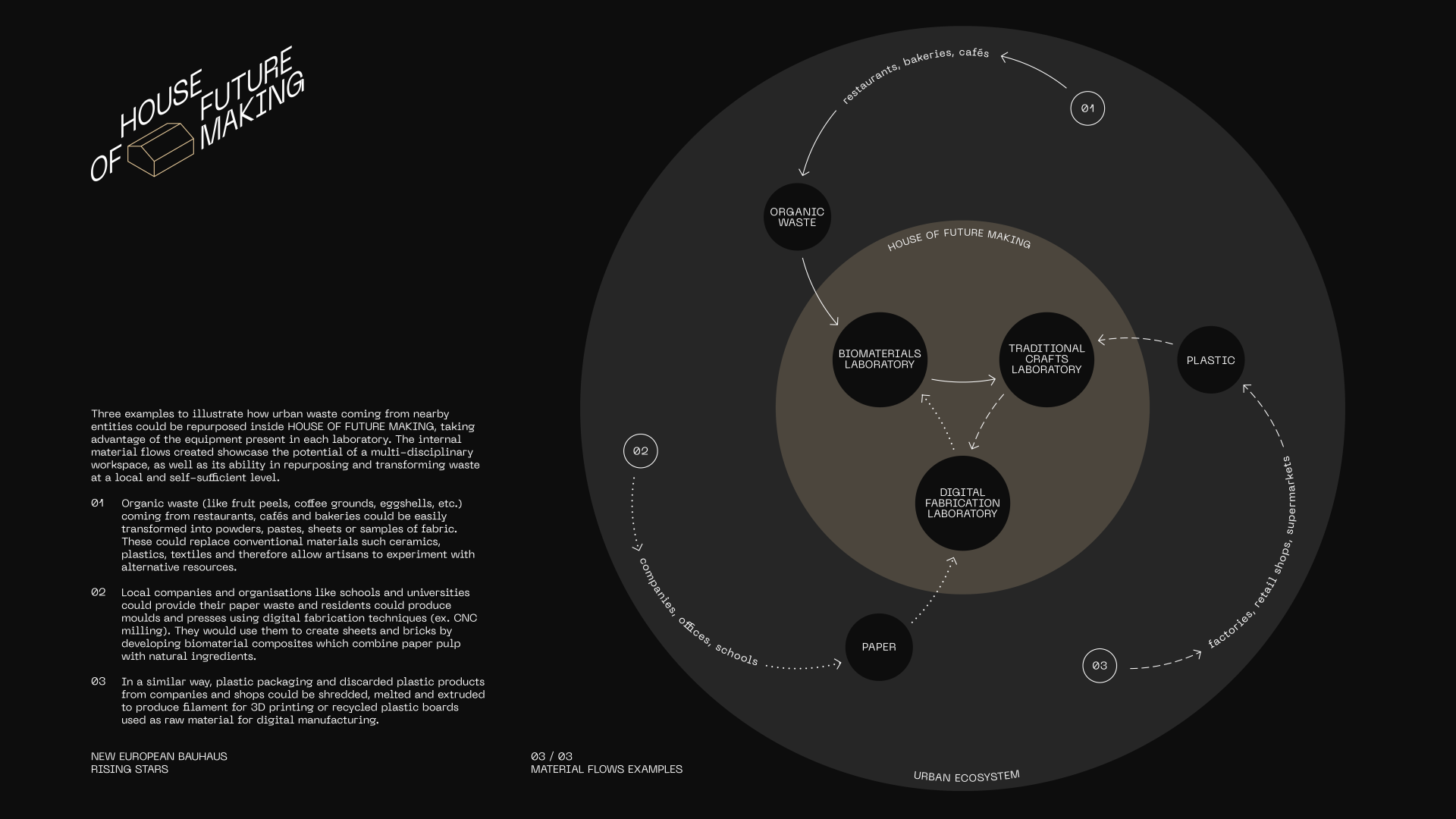House of Future Making
Basic information
Project Title
Category
Project Description
House of Future Making is a shared co-making space for designers, artisans and material engineers, who want to transform urban waste and by-products of nearby companies into valuable, ethically-made objects for the local community. Using both digital fabrication and traditional craft techniques, and fostering a circular economy of “made in the neighbourhood, for the neighbourhood”, we aim to bring manufacturing back into the city and enable the community to be self-sufficient and resilient.
Geographical Scope
Project Region
Urban or rural issues
Physical or other transformations
EU Programme or fund
Which funds
Description of the project
Summary
Globalisation has led European cities to lose their manufacturing capacity. More and more neighbourhoods once dedicated to production are now being transformed into ones for consumption, turning the city into an avid passive consumer: importing products and exporting waste. We need to reinvent the city by decentralising and re-localising production, recovering the knowledge and skills of how things are made, and granting new designers easy and affordable access to the advanced technologies that can make it happen.
House of Future Making is a shared workspace functioning as a hybrid between a co-working space for makers, a micro-factory for the neighbourhood, and an open innovation lab for small local companies.
The workspace consists of 3 interconnected labs:
— Digital Fabrication Lab (for 3D printing, CNC milling, laser cutting);
— Biomaterials Lab (for incubating, fermenting, dehydrating, experimenting with organic waste):
— Traditional Crafts Lab (for wood and metal working, textile weaving and sewing, pottery, plastic and paper recycling).
Designers, makers and artisans hosted as residents inside House of Future Making use the shared spaces, equipment and tools to create their products, objects and works taking advantage of the material leftovers, waste and by-products coming from nearby factories and companies. The idea is to create a material flow within the neighbourhood itself, so that makers can produce their pieces at a local level and companies can avoid sending waste to landfills or abroad for recycling.
The goal is to allow professional creatives to get closer to the cutting-edge tech equipment they could not afford by themselves, and at the same time take advantage of the resources already present in the city, creating a no-waste ecosystem of closed loops. With this, we hope to support the local economy, decrease the reliance on global supply chains and enable a wider local participation in design and production systems.
Key objectives for sustainability
The idea at the core of the project starts as a reaction to both the linear manufacturing model and the consumerist lifestyle that are promoted (and caused) by the globalisation of the city. In particular, as a reaction to the mass production system which relies almost entirely on extracting and shipping materials, products and their waste all around the world.
We see the project as a way for cities to tackle these issues and to explore how things could run under an alternative model. The way of working of House of Future Making takes advantage of local resources as much as possible, rethinks the companies’ waste as raw material, and keeps resources economically productive as long as possible, therefore reducing the emissions of production and transportation.
It is indeed a model entirely based on sharing. This means allowing tools and machines to be used in common with others, employing them at their full capacity, making the most out of what already exists, and enabling residents to avoid having to get their own equipment. Sharing also implies using materials which can be fed back into the loop, so that one person’s trash becomes another person’s raw material.
Moreover, the central role of local making and slow local design enables us to put a face behind the production of goods, to reconnect with the values of the products we buy, and to make more conscious choices. Because by promoting an economy of demand, instead of an economy of supply, we can create a system that avoids the time-consuming, expensive and unsustainable deliveries, that reduces the need for stock storage, and that empowers the local craftsman and makers.
Ultimately, we believe that if cities decide to invest in the knowledge, skills and infrastructures necessary to start to produce everything locally, this will translate in less imported products and in more recycled materials used for the production of goods.
Key objectives for aesthetics and quality
House of Future Making as a physical space requires its architecture (not in terms of the building itself, but in terms of the actual design of the space) to closely relate to—and in certain sense, to encourage—its content. We believe that new design practices, like the hybridisation of digital fabrication, biomaterials and crafts, need new spatial forms.
The arrangement of the space derives from a study of already-existing workspaces, such as co-working spaces, makerspaces and artisanal ateliers, and combines them into a new solution able to highlight the best of each one. In addition, its layout is also meant to reflect the intangible key features of the project: openness, transparency and flexibility—but also creativity in general, and a sense of randomness.
The process behind the development of the layout design and aesthetics of House of Future Making comes from the conviction that buildings and spaces unavoidably speak to us about the kind of life that may possibly occur within them. They are able to foster certain moods, certain attitudes and, as a consequence, certain types of works.
To follow the open nature of the project, the space should invite cross-contamination between making practices, between techniques, and especially between all the different expertise coming from the residents themselves. In this sense, we believe that the physical space is also a work tool, apt to enable meaningful flows and dialogues. For this reason, tools, equipment and machines are not simply placed in the room, but are taken into consideration as central part of an overall thoughtful environment derived from both layout and content.
As an organisation focused on future innovation, the structure has to allow and incentive not only creativity, but constant progress and evolution. This is why we want to make sure that House of Future Making, both as a business and as a workspace, is set up to evolve over time.
Key objectives for inclusion
Over the last 100 year we have witnessed the concentration of the means for production in the hands of a few. The very idea of House of Future Making wants to be a first step towards changing that. What we believe is necessary today, in face of the current social, environmental and economic challenges, is a way to democratise the means of production and make them accessible to all, at a neighbourhood level. This is why we envision a future where local making takes an indispensable role, and where artisans and makers—empowered by the necessary tools and infrastructures—become the fundamental key players of a distributed production system.
A decentralised and localised model like the one we promote would not of course be thinkable today, if it were not for the rapid advancement of digital fabrication, which allows designers to move into areas of production that were previously the exclusive domain of large corporations. Enabling local makers to have access, at a reasonable price, to these technologies with a spirit of collaboration and sharing is the cornerstone of the whole project.
Working as a circular innovation hub for local companies, it also enables those small-sized businesses which do not have the necessary resources to build their own R&D lab to participate in new solutions and new economic models, giving them the possibility to think outside their current core business and to adapt to future shifts.
We also believe that innovation in design and manufacturing could not happen without the active participation of the community. We want people to really interact with the projects developed inside House of Future Making, by hosting events like exhibitions, talks and workshops. This can be helpful for the residents as well, to be known and discovered by new and different groups of people. And at the same time it is a way to involve the larger local community, who would not otherwise have the chance of taking part and engaging with these new practices.
Physical or other transformations
Innovative character
The transition that the project promotes—bringing manufacturing back into the city in a no-waste economy model—is ambitious and one of the greatest challenges of our time: we know this very well. And the project itself consists of several intricate layers in terms of network and organisation. Still, we believe that complex issues can not be resolved by simple solutions. We can not talk about changing production, its globalisation and its negative impact on the environment, without talking about the larger systems in which it sits, including governance, education and social rights.
This is why the different components at the heart of the project are all fundamental and have to coexist in order to create a structure able to lower the barrier to entry in design and manufacturing, make open collaboration and creativity happen, and support a local circular economy.
The combination of all these aspects allows transversal synergies between different entities, supporting the vision of a circular interconnected ecosystem, made of shared and nested circles, where different companies complement and need each other. The network-driven structure of House of Future Making gives the possibility to be part of this change not only to new designers but also small businesses, by sharing materials and practices with its residents or by directly contributing to their research and design projects.
At the same time, it is hard to imagine an open circular production without sharing knowledge and without inviting in as many entities as possible (community, companies, public institutions). Because if every part keeps its processes, materials and waste secret, how can you create an economy where the leftovers of one can be used by another one? This requires an unprecedented level of cooperation, a transparent access to each other protocols, processes and material flows, as well as an appropriate infrastructure able to host their exchanges, like the one proposed by House of Future Making.



